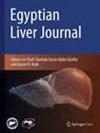Rifaximin alone vs combination with norfloxacin for secondary prophylaxis of spontaneous bacterial peritonitis with hepatic encephalopathy: randomized controlled trial
IF 0.7
Q4 GASTROENTEROLOGY & HEPATOLOGY
引用次数: 0
Abstract
In liver cirrhosis, events of spontaneous bacterial peritonitis (SBP) and hepatic encephalopathy (HE) portend a poor prognosis. Gut dysbiosis remains a common pathogenetic mechanism for both SBP and HE. Recent data suggests the role of rifaximin in gut modulation and improving intestinal dysbiosis. Due to emergence of multidrug-resistant organisms, gut-selective antibiotics with minimal systemic effects are warranted for secondary prophylaxis in patients of cirrhosis. We compared rifaximin alone vs combination with norfloxacin for secondary prophylaxis of patients of cirrhosis presenting with SBP and HE. This was a prospective, open-label, RCT which included all patients of cirrhosis with SBP and HE on admission. On discharge, in addition to standard medical treatment, patients were randomized to rifaximin 400 mg three times a day (group I) and rifaximin 400 mg three times a day with norfloxacin 400 mg once a day (group II) as a secondary prophylaxis of SBP. Primary outcomes were recurrent episodes of SBP and HE at 6 months and 28-day, 90-day, and 6-month mortalities. Secondary outcomes included number of rehospitalizations, episodes of upper gastrointestinal bleed, new acute kidney injury episodes, and change in Child–Turcotte–Pugh (CTP) and model for end-stage liver disease (MELD) scores over next 6 months. After screening 87 patients of cirrhosis with SBP and HE, 12 patients had in-hospital mortality and another 25 were excluded, one patient was lost to follow-up, and, finally, 49 patients were randomized into group I (n = 24) and group II (n = 25). The HE was grade 2 (18 vs 16) and grade 3 (6 vs 9) in groups I and II respectively. Primary outcomes as recurrent SBP (3 vs 2; P = 0.67); recurrent HE at 6 months (5 vs 2; P = 0.24); and 28-day (2 vs 2; P = 1.0) and 90-day mortality (4 vs 3; P = 0.72) and 6-month mortality (6 vs 8, P = 0.52) were comparable between two groups respectively. Secondary outcomes as number of rehospitalizations (3 vs 8, P = 0.07), new episodes of UGI bleed (2 vs 3, P = 0.1), new AKI episodes (4 vs 1, P = 0.06), ∆CTP (− 4 vs − 4), and ∆MELD (− 9 vs − 8) over the next 6 months were not significantly different between two groups respectively. Rifaximin was effective in secondary prevention of both SBP and HE in patients of cirrhosis. The randomized controlled trial was registered in CTRI/2021/09/036321 dated September 7, 2021.单用利福昔明与联合诺氟沙星对伴有肝性脑病的自发性细菌性腹膜炎进行二级预防:随机对照试验
在肝硬化患者中,自发性细菌性腹膜炎(SBP)和肝性脑病(HE)预示着不良的预后。肠道菌群失调仍是 SBP 和 HE 的常见致病机制。最近的数据表明,利福昔明在调节肠道和改善肠道菌群失调方面发挥了作用。由于多重耐药菌的出现,肝硬化患者需要使用对全身影响最小的肠道选择性抗生素进行二级预防。我们比较了利福昔明单独使用与诺氟沙星联合使用对出现 SBP 和 HE 的肝硬化患者进行二级预防的效果。这是一项前瞻性、开放标签的 RCT 研究,包括所有入院时出现 SBP 和 HE 的肝硬化患者。患者出院时,除接受标准药物治疗外,还随机接受利福昔明 400 毫克,每天三次(I 组);利福昔明 400 毫克,每天三次,同时服用诺氟沙星 400 毫克,每天一次(II 组),作为 SBP 的二级预防药物。主要结果为 6 个月时 SBP 和 HE 的复发率,以及 28 天、90 天和 6 个月的死亡率。次要结果包括再次住院次数、上消化道出血发作次数、新的急性肾损伤发作次数以及未来 6 个月内 Child-Turcotte-Pugh (CTP) 和终末期肝病模型 (MELD) 评分的变化。在对87名患有SBP和HE的肝硬化患者进行筛选后,12名患者出现院内死亡,另有25名患者被排除在外,1名患者失去随访,最后,49名患者被随机分为I组(24人)和II组(25人)。I 组和 II 组的 HE 分别为 2 级(18 对 16)和 3 级(6 对 9)。两组的主要结果分别为:复发 SBP(3 对 2;P = 0.67);6 个月时复发 HE(5 对 2;P = 0.24);28 天(2 对 2;P = 1.0)和 90 天死亡率(4 对 3;P = 0.72)以及 6 个月死亡率(6 对 8,P = 0.52),两组结果相当。两组患者在接下来的 6 个月中再住院次数(3 vs 8,P = 0.07)、新的 UGI 出血发作(2 vs 3,P = 0.1)、新的 AKI 发作(4 vs 1,P = 0.06)、∆CTP(- 4 vs -4)和∆MLD(- 9 vs -8)等次要结果无显著差异。利福昔明对肝硬化患者的 SBP 和 HE 二级预防均有效。该随机对照试验已于2021年9月7日登记在CTRI/2021/09/036321号文件中。
本文章由计算机程序翻译,如有差异,请以英文原文为准。
求助全文
约1分钟内获得全文
求助全文

 求助内容:
求助内容: 应助结果提醒方式:
应助结果提醒方式:


